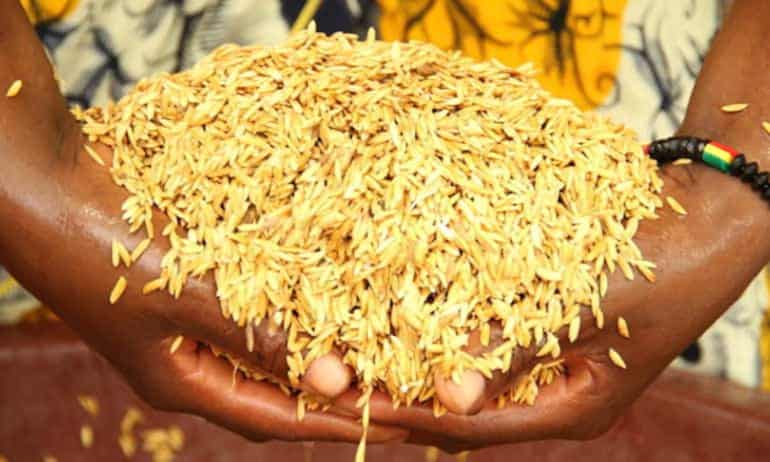A new report from the West and Central African Council for Agricultural Research and Development (CORAF) describes the results from “the largest System of Rice Intensification (SRI) project ever undertaken in the world,” according to technical lead for regional coordination Dr. Erika Styger. It reveals higher yields for rice farmers in West Africa using SRI. SRI is an adaptable rice farming methodology for reducing the need for inputs, including agrochemicals, while increasing yields.
Rice is an important crop in West and Central Africa—most of the 430 million people living in the region depend on it as a staple—but West Africa currently consumes more than it produces and has been importing rice from other parts of the world, such as Asia. A regional offensive initiated by the Economic Community of West African States (ECOWAS) aims to change this by increasing regional rice production.
Organizations and farmers are working toward this goal through initiatives such as the “Improving and Scaling up the System of Rice Intensification in West Africa” project (SRI-WAAPP). This three-year project involved more than 50,000 rice farmers, more than 1,000 sites, and 13 West African countries. It was coordinated by the National Center of Specialization on Rice in Mali along with Cornell University through the West Africa Agricultural Productivity Program (WAAPP)—a program of CORAF. The project is “one of the most successful in the CORAF portfolio,” says CORAF’s Executive Director Dr. Abdou Tenkouano. “This SRI project has been groundbreaking in its participatory design and implementation.” “The involvement of the rice stakeholders in the 13 countries since the design of the project was the key factor of success during its implementation,” Dr. Gaoussou Traoré, the project’s regional coordinator, tells Food Tank when asked about this participatory design.
According to the report, use of SRI shows promise for helping rice farmers meet the growing demand in the region. In fact, authors Styger and Traoré write that complete adoption of this method in 2017 would have eliminated the need for rice imports. They also estimate that just in the 2015-2016 growing season, use of SRI produced more than an additional 20,000 tons of milled rice at the project sites, valued at about US$10 million.
The report details yields for farmers using SRI compared with farms using conventional growing practices. An independent evaluation in five countries found that yields increased by 54 percent, 65 percent, and 153 percent for irrigated, rainfed lowland, and rainfed upland systems, respectively. It also found a 41 percent average increase in farmers’ incomes. The project team’s assessment of overall results found even higher yield increases for irrigated and rainfed lowland systems, at 56 percent and 86 percent, respectively. Given these findings, the authors advocate for further scale-up of SRI in the region: “If SRI is to make a real contribution to rice self-sufficiency in West Africa, many more farmers must adopt it.”
However, “successful expansion of SRI will depend on adapting SRI practices to local environments,” say Styger and Traoré. Because SRI is an approach based on a set of principles—rather than a static technology—it is adaptable to farmers’ diverse circumstances, such as irrigated or rainfed systems and different ecological characteristics. “The practices, of course, should always be adapted to suit local conditions,” says Norman Uphoff, Senior Advisor for the SRI International Network and Resources Center (SRI-Rice) program at Cornell University. “We see SRI more as a menu than as a recipe.” Dr. Traoré explains that participants of the SRI-WAAPP project used a conceptual framework based on four defining and unchanging principles—“the backbone of SRI”—while agreeing that “the rice production practices or techniques used to implement the four principles may vary and need to be adapted to local agro-socio-economic conditions.”
Though SRI is far from full adoption, the methodology has been spreading around the world and is used in more than 50 countries. Consequently, SRI is used in a wide variety of socioeconomic contexts and can look different between communities and between farms. For example, in some cases where SRI decreases labor requirements, people have raised concerns that its economic benefits will not extend to groups like landless farm laborers. On the other hand, sometimes SRI intensifies labor requirements, particularly while farmers become familiar with it and learn what practices work best for their farms.
CORAF’s Regional Gender and Social Development Adviser Dr. Mariame Maiga worries that SRI’s labor intensity could place additional burdens on women who already have significant responsibilities in addition to agricultural work, including cooking, obtaining water, and caring for children. “Women have to work very hard with SRI to produce rice,” she tells Food Tank. Dr. Maiga recommends that steps be taken to prevent SRI adoption from overburdening women and exacerbating gender disparities. In response, the team adopted a labor-saving weeding technology from India to help make SRI more convenient.
This is just one example of how projects can adjust their SRI implementation, and farmers and organizations all over the world have been finding new ways to adapt SRI. Because the SRI-WAAPP project was so large, the team was able to foster cross-border collaboration: “The regional nature of this project made it possible to connect researchers, extension staff, and farmers working under similar conditions across West Africa and help them to identify and share innovations,” say the report’s authors. “This enabled faster dissemination, adaptation, and adoption of SRI to different rice production systems, ultimately leading to better results.”
Photograph courtesy of CORAF.











